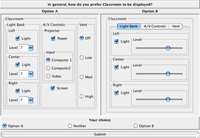ARNAULD: Preference Elicitation For Interface Optimization
 Recent years have revealed a trend towards
increasing use of optimization as a method for automatically designing
aspects of an interface's interaction with the user. In most cases,
this optimization may be thought of as decision-theoretic --
the objective is to minimize the expected cost of a user's
interactions or (equivalently) to maximize the user's expected
utility. While decision-theoretic optimization provides a powerful,
flexible, and principled approach for these systems, the quality of
the resulting solution is completely dependent on the accuracy of the
underlying utility or cost function. Unfortunately, determining the
correct utility function is a complex, time-consuming, and error-prone
task. While domain-specific learning techniques have been used
occasionally, most practitioners parameterize the utility function and
then engage in a laborious and unreliable process of hand-tuning.
Recent years have revealed a trend towards
increasing use of optimization as a method for automatically designing
aspects of an interface's interaction with the user. In most cases,
this optimization may be thought of as decision-theoretic --
the objective is to minimize the expected cost of a user's
interactions or (equivalently) to maximize the user's expected
utility. While decision-theoretic optimization provides a powerful,
flexible, and principled approach for these systems, the quality of
the resulting solution is completely dependent on the accuracy of the
underlying utility or cost function. Unfortunately, determining the
correct utility function is a complex, time-consuming, and error-prone
task. While domain-specific learning techniques have been used
occasionally, most practitioners parameterize the utility function and
then engage in a laborious and unreliable process of hand-tuning.
Krzysztof Z. Gajos, Jacob O. Wobbrock, and Daniel S. Weld. Improving the performance of motor-impaired users with automatically-generated, ability-based interfaces. In CHI '08: Proceeding of the twenty-sixth annual SIGCHI conference on Human factors in computing systems, pages 1257-1266, New York, NY, USA, 2008. ACM.
Best Paper Award
[Abstract, BibTeX, Video, Authorizer, etc.]
Krzysztof Gajos and Daniel S. Weld. Preference elicitation for interface optimization. In UIST '05: Proceedings of the 18th annual ACM symposium on User interface software and technology, pages 173-182, New York, NY, USA, 2005. ACM Press.
[Abstract, BibTeX, Slides, Authorizer, etc.]
 Recent years have revealed a trend towards
increasing use of optimization as a method for automatically designing
aspects of an interface's interaction with the user. In most cases,
this optimization may be thought of as decision-theoretic --
the objective is to minimize the expected cost of a user's
interactions or (equivalently) to maximize the user's expected
utility. While decision-theoretic optimization provides a powerful,
flexible, and principled approach for these systems, the quality of
the resulting solution is completely dependent on the accuracy of the
underlying utility or cost function. Unfortunately, determining the
correct utility function is a complex, time-consuming, and error-prone
task. While domain-specific learning techniques have been used
occasionally, most practitioners parameterize the utility function and
then engage in a laborious and unreliable process of hand-tuning.
Recent years have revealed a trend towards
increasing use of optimization as a method for automatically designing
aspects of an interface's interaction with the user. In most cases,
this optimization may be thought of as decision-theoretic --
the objective is to minimize the expected cost of a user's
interactions or (equivalently) to maximize the user's expected
utility. While decision-theoretic optimization provides a powerful,
flexible, and principled approach for these systems, the quality of
the resulting solution is completely dependent on the accuracy of the
underlying utility or cost function. Unfortunately, determining the
correct utility function is a complex, time-consuming, and error-prone
task. While domain-specific learning techniques have been used
occasionally, most practitioners parameterize the utility function and
then engage in a laborious and unreliable process of hand-tuning.